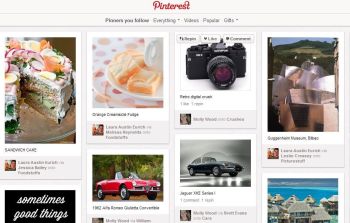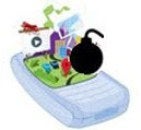 Content-sharing site Pinterest has been surging in popularity. The bigger it gets, the more responsibility it has to ensure that copyrighted content doesn't show up on its site.
Content-sharing site Pinterest has been surging in popularity. The bigger it gets, the more responsibility it has to ensure that copyrighted content doesn't show up on its site.
Less than a week after Pinterest offered an opt-out code for websites seeking to protect their content, Flickr is adopting that code to help users protect copyrighted images on its photo-sharing network.
If you're fitting Pinterest into your company's marketing plans, or seeking to protect your content from eager Pinterest users, what should you do?
Pinterest: A Copyright Nightmare?
How is sharing a picture on Pinterest any different than on other social networks? Both Twitter and Facebook encourage sharing personal experiences and photos rather than content created by someone else, says Deborah Sweeney, intellectual property lawyer and and CEO of MyCorporation. While Facebook users repurpose others' content regularly, Facebook asks each time you upload a photo if you have the permission to use it. The legal burden lies with the original person who posted the photo rather than those who share links to it.
Pinterest does not ask users to consider permissions before each "pin," aiming to make the user experience seamless. While having your content shared arguably helps popularize it, many artists and photographers may want to be asked or paid first.

 What if General Mills objected to my "pin?"Sweeney says Pinterest's business model is the issue, since its "very nature is to encourage the repinning of photos, which encourages users to use them as they like." She argues that it isn't a far leap for users to think it's fine to use a picture from one of their Pinterest boards on a website or blog, although this is expressly against Pinterest's Terms of Service.
What if General Mills objected to my "pin?"Sweeney says Pinterest's business model is the issue, since its "very nature is to encourage the repinning of photos, which encourages users to use them as they like." She argues that it isn't a far leap for users to think it's fine to use a picture from one of their Pinterest boards on a website or blog, although this is expressly against Pinterest's Terms of Service.
As an example, here's a pin I made of a 1980s advertisement for General Mills coffee. If General Mills wanted to take exception to my use of its copyright, it could ask Pinterest to take down the offending advertisement by following Pinterest's directions here. However, according to Pinterest's Terms of Use, it's my responsibility to get General Mills' permission prior to posting anything involving its trademark.
Pinterest offloads legal responsibility onto users, but takes action on copyright infringement itself. Why not let the artists deal with the infringing users directly? Pinterest can remove an infringing item faster than a user can, and it has that right under its Terms of Use.
Pinterest Places Copyright Responsibility on Users
Pinterest does have a stringent policy that the user is not to use third-party content for anything but a personal content collection on the site. But it falls down in its Terms of Use: "You acknowledge and agree that you are solely responsible for all Member Content that you make available through the Site, Application and Services."
The inherent flaw in the legal logic, as Sweeney puts it, is that the images remain on Pinterest's site, even if a user has curated them into a personal collection. "Pinterest would have a hard time defending itself by forcing the liability onto a user. A court could possibly find it libel for a contributory infringement." Chilling Effects, a site that collects and analyzes legal complaints about online activity, seems to agree:"Providing a forum for uploading or downloading any copyrighted file or cracker utility may also be contributory infringement".
If, however, your business hopes for its content to be "pinned" to Pinterest, first check with your product photographer that you own all rights to the images and that repinning would be an accepted use, since you may have only paid for the images to be used on your own website.
Pinterest's 'Nopin' Code

 If you need the publicity, don't block your own images from being "pinned."If you want to shield your content from Pinterest, its “nopin” code lets websites block images from being pinned. Just include this snippet within the section of the HTML:
If you need the publicity, don't block your own images from being "pinned."If you want to shield your content from Pinterest, its “nopin” code lets websites block images from being pinned. Just include this snippet within the section of the HTML:
Although this code and its predecessors--scripts that prevent downloads of images--may deter theft of copyrighted photos, determined users can always take screen captures as a workaround.
On Flickr, by default images that are marked as copyrighted or protected can't be pinned. As the company told VentureBeat on Friday, "only content that is 'safe,' 'public' and has the sharing button enabled can be pinned to Pinterest."
What More Can Pinterest Do?
Pinterest has a page devoted to copyright, and a copyright agent who artists and their representatives can contact to have infringing material removed. While Pinterest is doing a lot to give aggrieved artists, photographers, and copyright lawyers the tools they need to deal with infringement after the fact, Sweeney says it should do more.
"Pinterest could work out an agreement with the larger image providers, and figure out a way to compensate third-party licensees so the image providers get a cut. Individual copyright owners may be the losers in this, since they don't have the negotiation power or the funds to litigate an infringement."
The root problem is that Pinterest’s core concept is about repurposing third-party content, which is supposed to be properly licensed, attributed, or paid for before being pinned. But users simply aren't going to take that extra step.
While the "nopin" code is a step in the right direction, Pinterest may have to do more to restrict the free flow of copyrighted images, which could land both itself and its users in hot water.









 If you’re coming to our site after having seen MAKE’s founder Dale Dougherty on CNN’s The Next List, welcome! We thought we’d take this opportunity to introduce you (and others who might be new to MAKE) to some of what we do here and why. We’ve got a lot of different things going on and are tremendously excited by the work we do and the global community of do-it-yourself (DIY) enthusiasts with whom we collaborate.
If you’re coming to our site after having seen MAKE’s founder Dale Dougherty on CNN’s The Next List, welcome! We thought we’d take this opportunity to introduce you (and others who might be new to MAKE) to some of what we do here and why. We’ve got a lot of different things going on and are tremendously excited by the work we do and the global community of do-it-yourself (DIY) enthusiasts with whom we collaborate.




Posting comment ...